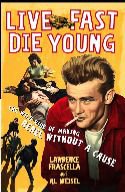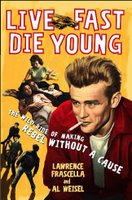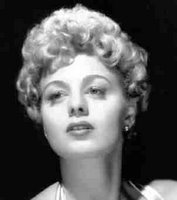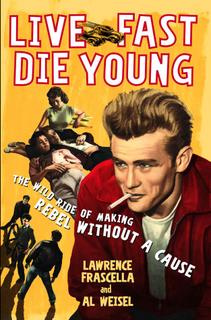
We were very saddened to learn that
Rebel Without a Cause costume designer Moss Mabry has passed away. In
Live Fast, Die Young: The Wild Ride of Making Rebel Without a Cause we reveal for the first time that according to Mabry he designed the legendary red jacket that James Dean wore in the film. Although other sources claim that the jacket had other origins, no one apparently had ever interviewed him about it before. "Even though the jacket looked simple, it wasn't," he told us. Mabry made three of them. He also told us that years later, while working on the film
Continental Divide with John Belushi,
Belushi ordered him to fly back to Hollywood and make three more red jackets just like James Dean's, one for him and two for each of his bodyguards.
Although Mabry was nominated for four Academy Awards, he never got credit for what may have been his most famous design until we talked to him for our book. Mabry also told us about a special bra he designed for Natalie Wood, which became known as the "Natalie Wood bra," though he declined to reveal the secret of its design. After
Rebel Mabry worked on
Giant, earning his first Academy Award nomination. Although we are very sad about his passing, we are happy we gave him the opportunity to tell his story, especially about the red jacket. Here is his obituary from
The Los Angeles Times:
Moss Mabry, 87; Costume Designer Was Nominated for 4 Academy AwardsBy Dennis McLellan, Times Staff Writer
Moss Mabry, an Academy Award-nominated costume designer whose credits include "Giant," "Rebel Without a Cause" and "The Way We Were," has died. He was 87.
Mabry, a former West Hollywood resident who retired two decades ago to Vista in San Diego County, died Wednesday at a hospital in nearby Oceanside after a long illness that included respiratory and heart problems, said longtime friend Gary More.
In a career that spanned more than 80 films between 1953 and 1988, Mabry worked with such stars as Lana Turner, Grace Kelly, Goldie Hawn and Liza Minnelli, as well as leading men such as Marlon Brando, John Wayne, Dean Martin and Robert Redford.
"I was really so sorry to hear about Moss because he was such a dear, sweet man," Doris Day said in a statement to The Times on Thursday. "He designed my clothes on many of my films, and we always had laughs and a great time working together."
Mabry earned four Academy Award nominations -- for "Giant" (with colleague Marjorie Best), "What a Way to Go!" (with Edith Head), "Morituri" and "The Way We Were" (with Dorothy Jeakins).
Among his other film credits are "The Bad Seed," "Mutiny on the Bounty" (1962 version), "Bob & Carol & Ted & Alice," "Move Over, Darling," "Cactus Flower,"
"Butterflies Are Free," "King Kong" (1976 version), "The Shootist," "Continental Divide" and "The Toy."
"He was a totally delightful, witty and tremendously energetic personality,"
former Times movie reviewer Kevin Thomas said Thursday. "I always felt that as a designer, he had tremendous flair and imagination. And when it called for glamour, he could really deliver."
Mabry often said that his most difficult assignment was designing the clothes for Elizabeth Taylor in "Giant," the sprawling, Texas-set 1956 epic that also starred Rock Hudson and James Dean.
"The script called for 42 [clothing] changes, starting in 1924 and coming up to 1954," he once said in an interview. "George Stevens, the director, did not want to show any dates on the screen but let the clothes and hairstyles show the passing of time.
"It goes without saying, Miss Taylor's beauty is almost impossible to disguise under the worst clothes, and styles in 1924 though 1930 were pretty bad, but careful planning and her magic won me an Academy Award nomination."
Mabry said wardrobe tests can be "discouraging" because they are the first time the producer and director have seen the clothes, and "from the sketch to the real thing can come as a shock or a pleasant surprise," he said.
When he dressed Kelly for the first time -- for wardrobe tests for Alfred Hitchcock's "Dial M for Murder" -- it was a more than pleasant surprise.
"She 'sold' those clothes like I didn't dream possible, and it was actually difficult to decide which ones she should wear in the film," he said. "Miss Kelly knows exactly how to stand, how to sit and how to walk, and you have no idea how these three things can 'make' or 'kill' a beautiful dress."
What may be Mabry's most famous piece of costumery was more mundane than
glamorous: the red jacket worn by Dean in "Rebel Without a Cause."
Although one source reportedly claimed that an inexpensive red jacket was bought at a Hollywood men's store for use in the 1955 film, Mabry told Lawrence Frascella and Al Weisel -- the authors of the recent book
"Live Fast, Die Young: The Wild Ride of Making 'Rebel Without a Cause' " -- that he made three of the jackets from a bolt of red nylon and painstakingly worked on the size of the collar and the placement of the pockets.
"Even though the jacket looked simple," Mabry said, "it wasn't."
Born in Marianna, Fla., in 1918, Mabry earned a degree in mechanical engineering at the University of Florida and began his professional life as an engineer.
But he had designed costumes and built scenery for high school plays, and his interest in clothing design lured him from a job with the Florida State Highway Department to Hollywood.

After attending the Chouinard Art Institute, he worked for renowned designer Don Loper for three years. That, in turn, led to his signing a contract with Warner Bros.
Mabry advised young people aspiring to a designing career to "find out all you can about fabrics, silk, taffeta, chiffon, how they wear, how they drape, etc. Then get a job with a manufacturer downtown; get exposed to the making of clothes."
A memorial service for Mabry, who had no immediate survivors, will be held at 11 a.m. Feb. 18 at Buena Vista Baptist Church, 145 Hannalei Drive, Vista.
http://www.latimes.com/news/printedition/california/la-me-mabry27jan27,1,3011544.storyMoss Mabry, Rebel Without a Cause, James Dean, Natalie Wood, Film, Movies, Movie, Fashion
 An interview I did with director Alejandro Jodorowsky about the re-release of his film El Topo, which has been unavailable for 30 years, is up at Premiere magazine's website. Jodorowsky talks about his feud with Allen Klein, who owned the rights to the film and refused to make it available; John Lennon, who once said it was his favorite film; conducting Marilyn Manson's marriage ceremony dressed as the Alchemist from The Holy Mountain; and his next project King Shots. El Topo is also being released on DVD with The Holy Mountain and Fando & Lis next year. You can read the interview here.
An interview I did with director Alejandro Jodorowsky about the re-release of his film El Topo, which has been unavailable for 30 years, is up at Premiere magazine's website. Jodorowsky talks about his feud with Allen Klein, who owned the rights to the film and refused to make it available; John Lennon, who once said it was his favorite film; conducting Marilyn Manson's marriage ceremony dressed as the Alchemist from The Holy Mountain; and his next project King Shots. El Topo is also being released on DVD with The Holy Mountain and Fando & Lis next year. You can read the interview here.








